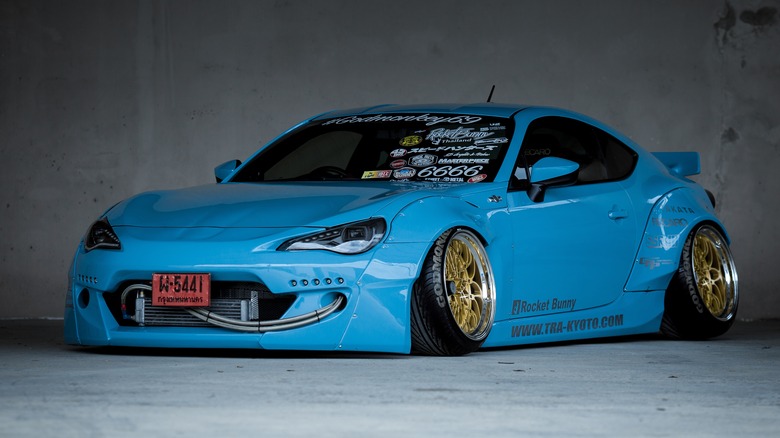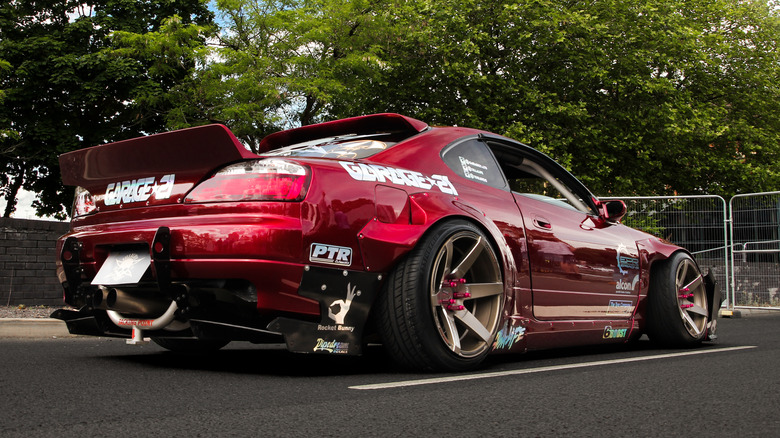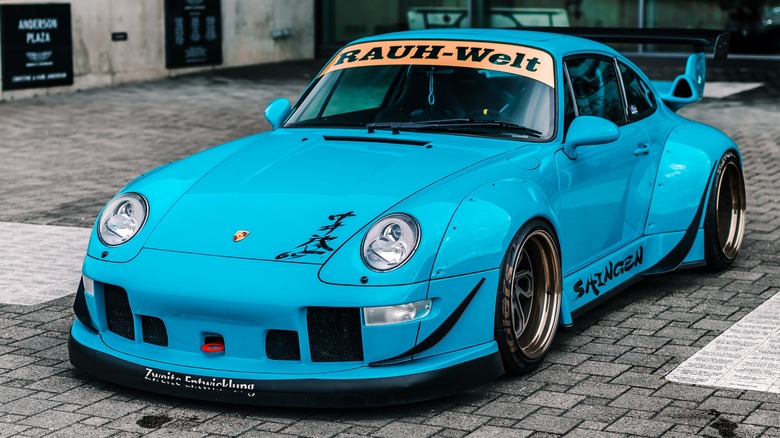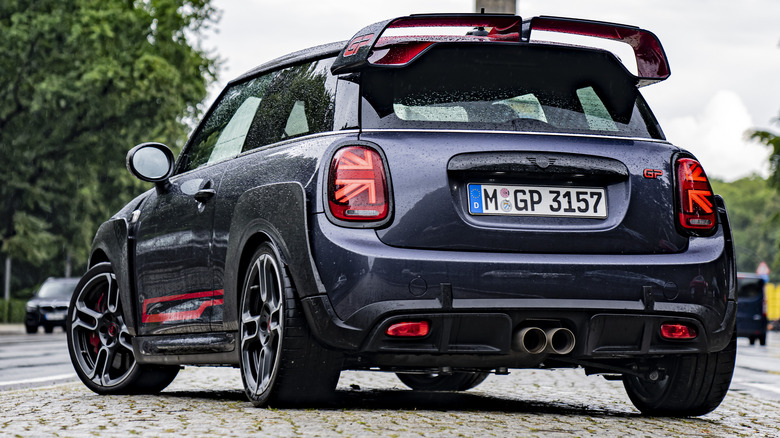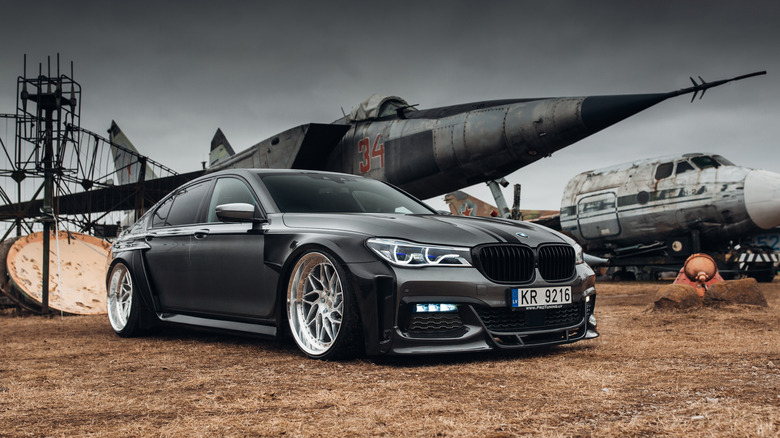Widebody Vehicle Kits: What Are They, And What's The Point?
If you've ever seen a modified car whose wheels are pushed out further than the outline of the body to give it a wider stance, and they are covered by what appears to be widened or bolt-on fender flares, then you were probably looking at a widebody kit. Its basic purpose is to cover the wheels in cars whose track width has been increased, but nowadays, the widebody kit has also become an aesthetic mod that people do to their cars to make them look sportier and more aggressive.
Finding the first widebody kit in history is tricky. The idea behind widebody kits arose out of necessity, and they were probably first used on racing cars whose factory track width didn't ensure enough stability for racing, so their suspension was modified and stance widened. But this pushed the wheels too far out, and they would hit the car's body or simply not fit.
One of the earliest widebody road cars is the Shelby Cobra. The widebody look was achieved by cutting around the wheel well to allow the wheel to have a complete range of motion without hitting the body, and then they added custom fender flares to cover the wheels.
There was no desire to hide how these early widebody kits were mounted since they served a functional purpose, not an aesthetic one, but over time, they also became a style statement. They also started appearing on modified road cars, and in many of these cases, more effort was put into making it seem as if the car was designed to be wide and less like the wide look was the result of adding bolt-on bits.
Performance improvements
By fitting a widebody kit to a car, you can change its suspension to make its handling more competent and predictable under hard driving, but you can also equip it with larger wheels and tires. These can dramatically increase the available levels of grip, allowing the vehicle to corner at higher speeds than before while maintaining a high level of stability.
Having a car with a wider stance will make a huge difference on track, where you will take corner after corner at high speed, and you want the car to be as stable and planted as possible, especially when the car is sent airborne after hitting a curb, and you want to regain control as quickly as possible.
If the widebody kit is designed by professionals with access to a wind tunnel, it can also be made to provide an aerodynamic boost, especially if fins or other aero elements are integrated into the design. Widebody kits with built-in aero are rare, but when you see one, you'll know you're looking at something special.
The combined effect of the improved suspension, better tires, and the aero enhancement will completely change how a car feels to drive without having to add any power or make any other modifications.
Types of widebody kit
Not all widebody kits are the same. They all usually require some cutting of the body panels, usually around the wheels, to avoid rubbing, but the necessity for other modifications depends on the type of body kit that you want to install.
If you're looking to just install some simple over-fenders to cover wheels that are sticking out a little bit more than stock, then you may not even have to cut the body. You could get away with just rolling the fender around the wheels until they no longer touch, then covering up your roll job with the over-fenders. The rolling doesn't have to look perfect in this instance, but you need to make sure the wheels clear the body before you install the bolt-on fenders.
For this type of widebody kit, you won't have to make any other changes to the car. However, if you want one of those full-body kits that often make the car not only wider but also longer overall, then this will require a lot more cutting of the original body and other modifications. It will also either come with or require special front and rear bumpers, new side skirts, as well as other components to add to the fenders, such as vents.
Some widebody kits are designed to be molded into the body. You add them before painting your car, then smooth the areas where the kit joins the body to hide the fact that they are add-ons. You then paint over everything and hide all the seams for a cleaner, more factory-like look.
Cars with factory widebody kits
Widebody kits aren't just offered as aftermarket solutions. Some manufacturers give certain special, usually limited-series vehicles, widebody kits from the factory. BMW, for instance, gives M models such as the M3 very aggressive-looking widened front and rear fenders, different bumpers, and side skirts to cover the bigger wheels that stick out more than on non-M cars. Audi and Mercedes-AMG also do this for certain models to mark them out as special high-performance variants.
One example of a current car that has what appears to be a bolt-on widebody kit with aero elements is the Mini Cooper John Cooper Works GP (pictured), which has some of the craziest-looking fenders of any modern car. The GP model has a wider stance than the regular Cooper S, so the Mini is equipped with carbon fiber wheel arch extensions that also have fins. The GP also has unique front and rear bumpers, as well as a huge wing in the back, but it's the unique fender treatment that screams "I'm special."
Porsche also used to offer regular and wide bodies for its 911 sports car, depending on the variant. Lower-powered versions got the narrow body, while spicier versions like the Turbo got bulging rear haunches to accommodate wider wheels. This distinction is no longer present in the 911 range, but you can still get versions with crazy wide fenders (even on the front) in the form of the GT3 RS, which is outrageous enough to still qualify as a factory widebody kit.
You can also get an optional widebody on the most powerful versions of the Dodge Charger and Challenger.
Cultural phenomenon
While at its origin, the need for a widebody kit arose out of necessity (to cover the wheels of modified cars with a wider-than-stock track width), things are different today. Some tuning enthusiasts will first put an aftermarket widebody kit on their car, then modify the suspension (often cheaply, using only wheel spacers) to bring the wheels out sufficiently to obtain the look they desire.
This is just a symptom of a much larger phenomenon of people making their cars look like they have at least 1,000 horsepower when, in fact, they just have visual modifications and no significant performance gains. GReddy's Rocket Bunny and Pandem are examples of aero kits that are very popular in the tuning community. They make any car look extreme, but for many modified vehicles with one of these kits, this might be the biggest mod, with only minimal supporting mods to tie everything together and nothing to boost the car's acceleration or cornering ability.
Widebody kits have become such a big part of car tuning culture that some enthusiasts will pay tens of thousands of dollars to have one custom-designed and fabricated for special one-off vehicles. It has become somewhat of a status symbol to have a widebody car since it can be expensive and difficult to get one; it's not just a simple bolt-on operation, and it says that you are very serious about the look and functionality of your modified car.
